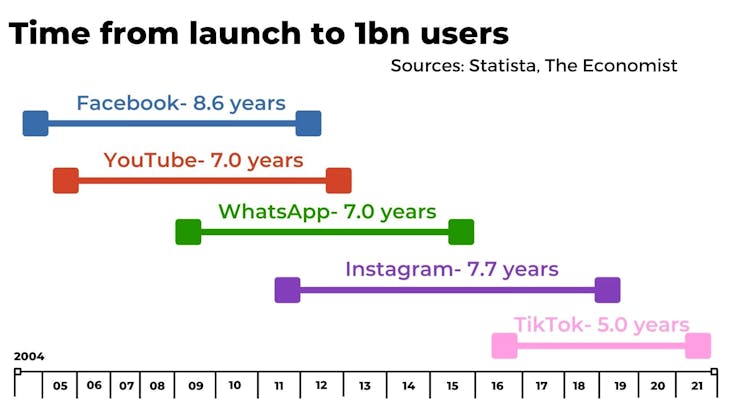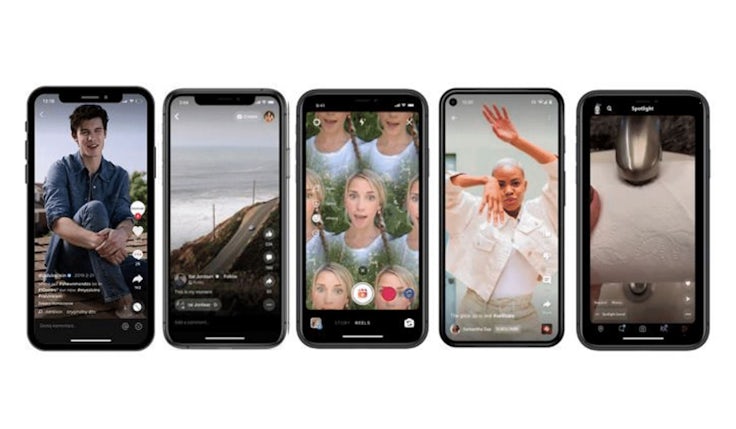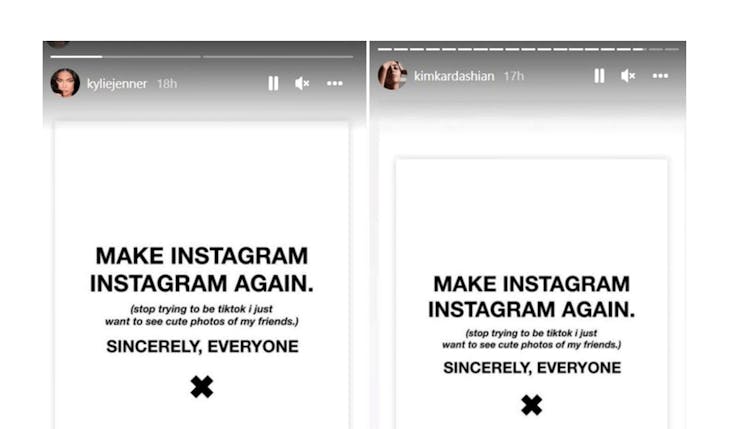You can’t beat TikTok by becoming its clone
Our marketing columnist examines the underwhelming response of the major social media brands to the TikTok threat and explores the perils of competitor orientation.
 There are only four attractive things about TikTok.
There are only four attractive things about TikTok.
There is its very large monthly active user base, which has just passed a billion people. There are the 45 minutes that those users spend, on average, on the site each day – higher than any other social media site. There is the platform’s peculiarly ad-appropriate design, which enables brands to blend promotional content seamlessly into TikTok’s endless video stream. And, finally, there is the meteoric growth that has seen user base, time spent and advertising revenue grow at unprecedented rates – even by the standards of the hyper-stimulated world of social media.
It’s a formula that can be extrapolated to gigantic possibilities in the decade ahead. And also one that leaves the traditional social media brands with a strategic headache.

It has been a frenetic decade-and-a-half since the invention of The Facebook, followed by the arrival of the other major social media platforms. All of them started small, hungry and aggressive. Each found its niche. And each built a gigantic and insanely profitable empire. But time passes, user trial turns to habit and innovation becomes industry standard.
Thus was it once, and thus it will always be.
Facebook, Instagram, YouTube and Snapchat were the disruptors who created a new industry before our eyes. Their user growth was immediate and astronomical because – freed from the tyranny of physical products and the traditional laws of distribution – audience recruitment and growth were unlimited.
The disruptors are now ripe for disruption.
But a decade is a very long time in social media. These brands are now the establishment. The once-unlimited growth of social media is now bound by the very real constraints of the number of eyeballs on the planet and minutes in the day. And those non-existent barriers to instant customer recruitment now work in an equally vertiginous manner in reverse. Consumers can leave in the same massive numbers today as they arrived back in the heady days of the new millennium. Add this all together and you reach a delicious and ominous realisation: the disruptors are now ripe for disruption.
And always remember the crucial asymmetry of innovation over time: that being a disruptor confers zero skill to handle disruption. Indeed, being good at the former might make you even more vulnerable to the latter. Just as most tennis players with super-powerful serves often struggle to return the ball well, those companies that built their incredible growth from aggressively targeting legacy companies are probably more vulnerable to those attacks themselves.
Insipid response
It’s in that context that the rise of TikTok proves so fascinating. It’s not just its impressive growth numbers, but the flabby, indolent response of those it now displaces with that growth. For all their billion-dollar budgets and talk of strategic agility, the established social media platforms are responding with an astonishingly underwhelming reaction to TikTok’s nascent ascent.
The first brand to recognise and respond to the threat was Instagram. In 2020 the platform introduced Reels. It was “a new way to create and discover short, entertaining videos on Instagram”. But the move was an almost literal attempt to replicate the functionality of TikTok, and ran directly against the inherent DNA of Instagram and why it was so beloved by so many users.
Instagram was about curation and connection and community, not recommended videos from an anonymous vortex of strangers. While video was part of Instagram’s success, it was also a demonstrably image-led platform, not a video site.
But the ‘innovations’ have continued, with ‘Suggested Reels’ from unconnected recommenders replacing more and more of the photos posted by friends. In a more recent move, Instagram has also been testing showing these videos in full-screen mode with vertical scrolling. Instagram’s competitor response can be summarised as consisting of three key changes:
- Rely more on video
- Make the videos shorter and full-screen
- Use an algorithm to recommend them to users rather than rely on user contacts
Sound familiar?
A few months later, YouTube announced its new prototype feature called Shorts. It was launched in India, where TikTok had been banned in September 2020 and rolled out globally a year later. Like Reels, YouTube Shorts looks a lot like TikTok – from the full-screen videos, to the sub-60-second length, to the vertical scrolling, to the likes and swipes.
Indeed, it’s so similar I remember confusing the hell out of a senior mate who works for Google, when I asked him how TikTok was able to advertise on YouTube and “switch me across” to its site without me realising it. I still remember his panicked face softening as he realised I had unwittingly been watching YouTube Shorts without realising it. YouTube’s response to TikTok consists of three main thrusts:
- Continue to rely on video
- But make these videos shorter and full-screen
- Use a different kind of algorithm to recommend them
Snapchat has been busy too. In late 2020, the platform launched Spotlight – a dedicated space within its app where users could watch short, vertically scrolled, full-screen videos of up to 60 seconds in length. Snapchat would use its algorithms to select and then surface the most engaging Snaps to display to users.

The Spotlight feature was made accessible through a fifth tab on Snapchat’s home screen and users were motivated to create and publish these sub-60-second videos via a $1m daily funding programme created by Snapchat itself. In a nutshell, Snapchat attempted to respond to TikTok with:
- A greater reliance on video
- Making these videos shorter and full-screen
- Using its algorithm to recommend these shorter videos to users
Meanwhile, Instagram’s older sister, Facebook, was also struggling with TikTok’s growth. During the first three months of 2022, iPhone users in America spent 78% more time on TikTok than on Facebook.
In April, Tom Alison, head of the Facebook app, sent out a six-page memo to his team. While TikTok was not mentioned once, the presence of the rival was inherent in every sentence. Also evident from the memo was the recognition that the nature of social media was changing, fast.
“Social media products – including our own – are delivering value by investing more in discovery engines that help people find and enjoy interesting content, regardless of whether it was produced by someone you’re connected to or not,” Alison wrote in his memo. “We see this both in research as well as in the growth of products like Reels, Watch and In-Feed Recommendations [IFR].”
Facebook had to evolve, Alison noted. Rather than prioritising posts from friends and those who users followed, the platform would transform into a “discovery engine” and use its own algorithm to recommend posts regardless of where they originated. Top of the list of things that would be “discovered” would be short-form video.
“While Facebook’s discovery engine is designed to support many different formats (text, photos, video and eventually metaverse experiences), our biggest gap today is around short-form video and that’s why we’re focused on integrating Reels in Home, Watch, IFR and Groups,” Alison explained.
To summarise, Facebook’s response to TikTok was a three-pronged approach that relied on shorter videos, shown full-screen and recommended by an algo rather than friends.
Competitor orientation
What is so wrong with all of this, you might wonder? Why not focus on competitors and what they do, and augment it by evolving your own offering? I’m often asked this question by marketers I train and who are shocked at the lack of competitor assessments that I recommend as part of brand diagnosis.
I like looking at competitors through customer’s eyes, but I’m less interested in the insights that can be derived from directly studying competitors. In fact, it turns out there are very good reasons not to focus too heavily on competitors, what they do and how they do it.
There is a long and rewarding literature on the power of market orientation and keeping the customer in your cross hairs at all times. And there is an equally persuasive literature on the perils of competitor orientation – of switching our gaze from our customers to our competitors and how they do things. And that danger multiplies significantly if these insights turn to action and we start to replicate our competitors’ moves in our own approach.
TikTok is nothing new – to marketers, it’s just another ad platform
There is the inherent double danger of doing something that suits your competitor and not you. Externally, the position, attraction and image of your brand is bound to certain things. And your rival, in this case TikTok, is bound to others. A focus on doing what it does leaves you vulnerable to attempting to offer things that aren’t your core and aren’t what customers want from you, and which are already being offered – in a superior way – by a competitor.
When Facebook internally announced its new TikTok-like features last month, one bemused employee voiced the fears that there was a “a real risk in this approach that we lose focus on our core differentiation (the social graph and human choice) in favor of chasing short-term interests and trends”. Spot on.
When Instagram began testing full-screen videos, making it practically identical to TikTok, the decision was met with howls of derision from users making this exact same point. They already had TikTok for a quick, algo-driven video fix and wanted Instagram for other, more enduring, community-based uses.
Kylie Jenner and Kim Kardashian agreed, and asked their combined 686 million followers on the platform to sign a petition to stop Instagram from “trying to be TikTok”. The protest had an impact and, within days of the initial launch, Instagram executives were eating shit and trotting out the old chestnuts about learning and listening.
“I’m glad we took a risk,” Instagram boss Adam Mosseri told the media last month. “If we’re not failing every once in a while, we’re not thinking big enough or bold enough.”

Importantly, however, Mosseri was not completely capitulating and clearly not getting the bigger point. He spoke of the need to “regroup” and then “come back with some sort of new idea or iteration”. The TikTokification of Instagram will continue, despite the fact that users don’t want Instagram to be TikTok. After all, they already have TikTok for that.
Core competency
A broader point is that, even if there were room for one of the existing brands to position themselves as a TikTok equivalent, it would lack the internal core competencies to beat the Chinese player at its own game.
YouTube has a bigger user base and a much larger archive of material to shrink down to sub-60-second fare, plus the brand position of offering online video. But it will still not beat TikTok, because the beating heart of that brand’s success is an algorithm that presents and re-presents videos with a preternatural ability to fulfill a user’s exact needs.
It’s a capability that has been built over time, tested, improved and perfected. YouTube plays in a different space, with different types of video and viewer interaction.
The only people who seem to get this point are those who work for TikTok -people like Blake Chandlee, who spent a decade at Facebook before joining TikTok in 2019 to become its president of global business solutions. “Facebook is a social platform,” Chandlee recently told CNBC. “They’ve built all their algorithms based on the social graph. That is their core competency. Ours is not.”
And, while all this TikTokification is going on, all these brands are also losing focus on their own optimum strategic trajectories. Facebook has famously pegged its future to the metaverse, Snapchat to the more myopic opportunities of AR and VR. Why is either brand spending millions of dollars and development hours on short-form video cartoons? It does not fit with the longer-term aspirations of either brand. By copying TikTok, both platforms will fail in the short term, but more importantly fail in the longer term by drifting from their strategic paths.
As strategy guru Roger Martin observes, we are set for “a financial bloodbath”. That’s the scenario he predicts when multiple companies go to the same market, with the same strategy, at the same time. And he is right.
We’ve beaten up differentiation for too long in marketing. Sure, there is no unique offering out there. And no one will ever own any attribute or association. But playing the game your way, to your strengths, on your terms remains one of the hallmarks of successful business strategy.
As strategy guru Roger Martin observes, we are set for a financial bloodbath.
A decade ago, the big social media platforms all did different things and did them well. As they now begin to converge on the same functionality and benefits, is a Martinesque bloodbath really so far away?
And for the distinctiveness junkies out there who are indifferent to the value of platform differentiation, let me make the same point differently. When every platform opts for short-form videos, derived from user-based sources, taking up the full screen of each app and scrolling vertically from one to the next, there ain’t a lot of pixels left for distinctive brand assets of any kind.
Remember my error mistaking YouTube and TikTok? Granted, I am digital laggard, but it is becoming an easier and easier mistake to make. Any which way you cut it, they all look, feel and operate the same.
And what if TikTok has got this wrong? It’s unlikely, but it needs to be included in the long list of risks that competitor orientation bestows on companies that follow others. At the very least, these companies lose any opportunity for first-mover advantage because they are always responding, always following. And at the very worst they follow their rivals into the wrong market, or the wrong strategy, or the wrong future.
When Terry Leahy took over at Tesco and inherited a supermarket obsessed with following its bigger rival Sainsbury’s, his biggest issue with this ‘strategy’ was that he was unconvinced that the rival supermarket was actually any good. Not only was Tesco adopting a second-hand strategy, it hadn’t been especially effective when it was brand new.
It’s unlikely TikTok has got things wrong. But one certain implication of the TikTokificiation of social media is that, as the formerly different players all coalesce around similar things for similar uses, new and underserved sectors of the social media market will come up for grabs – sectors that these competitor-obsessed rivals will miss. If everyone follows TikTok’s zig, there is room for Zag.com to emerge and do it differently.
Of course, it’s very easy for a wanker like me to write a critique like this because I don’t have to support a multibillion-dollar revenue stream and combat a Chinese algorithm firm that is doubling in size every eight seconds. I’m offering no answers to what the likes of Facebook or YouTube should do in the face of this challenge, just telling them what not to do.
An appropriate response to TikTok is a very difficult strategic challenge. But it is one that these companies could embark upon, were they not so unable to think strategically in the first place.
Of all the many disadvantages of competitor orientation, the biggest one is that it inhibits and ultimately destroys a company’s own strategic capability. When you look at your rival and adopt its approach, you look less and less at your own situation, advantages and options. The more a company copies a competitor’s strategy, the more it loses the ability to create its own.
Maybe the social media space is different. Maybe copying an entrant’s best feature and strongest advantage is possible and advantageous. Perhaps I’m an old fool applying precepts from the 20th century to a world that no longer plays by the same rules.
But maybe I’m right, and these giant social media companies are incapable of handling the disruption and competitor impact that they themselves enacted so successfully only a decade ago. In which case, the TikTokification of social media is one of the biggest strategic errors in decades.
Mark Ritson is the 2023 PPA Columnist of the Year and teaches marketing strategy on the Mini MBA in Marketing. Ritson will be on stage at the Festival of Marketing on 6 October, inviting the audience to score their own marketing capability with 10 tests of their current approach. Find out more here.







